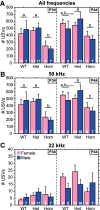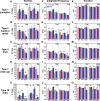Atypical Social Development in Vasopressin-Deficient Brattleboro Rats
- PMID: 27066536
- PMCID: PMC4822146
- DOI: 10.1523/ENEURO.0150-15.2016
Atypical Social Development in Vasopressin-Deficient Brattleboro Rats
Abstract
Over the past 3 decades, a large body of evidence has accumulated demonstrating that the neuropeptide arginine vasopressin (AVP) plays a critical role in regulating social behavior. The overwhelming majority of this evidence comes from adults, leaving a gap in our understanding of the role of AVP during development. Here, we investigated the effect of chronic AVP deficiency on a suite of juvenile social behaviors using Brattleboro rats, which lack AVP due to a mutation in the Avp gene. Social play behavior, huddling, social investigation & allogrooming, and ultrasonic vocalizations (USVs) of male and female rats homozygous for the Brattleboro mutation (Hom) were compared with their wild-type (WT) and heterozygous (Het) littermates during same-sex, same-genotype social interactions. Male and female Hom juveniles exhibited less social play than their Het and WT littermates throughout the rise, peak, and decline of the developmental profile of play. Hom juveniles also emitted fewer prosocial 50 kHz USVs, and spectrotemporal characteristics (call frequency and call duration) of individual call types differed from those of WT and Het juveniles. However, huddling behavior was increased in Hom juveniles, and social investigation and 22 kHz USVs did not differ across genotypes, demonstrating that not all social interactions were affected in the same manner. Collectively, these data suggest that the Avp gene plays a critical role in juvenile social development.
Keywords: play behavior; postnatal development; social behavior; ultrasonic vocalizations; vasopressin.
Figures






Similar articles
-
Sex differences in auditory brainstem response audiograms from vasopressin-deficient Brattleboro and wild-type Long-Evans rats.PLoS One. 2019 Aug 30;14(8):e0222096. doi: 10.1371/journal.pone.0222096. eCollection 2019. PLoS One. 2019. PMID: 31469871 Free PMC article.
-
Investigation of social, affective, and locomotor behavior of adolescent Brattleboro rats reveals a link between vasopressin's actions on arousal and social behavior.Horm Behav. 2018 Nov;106:1-9. doi: 10.1016/j.yhbeh.2018.08.015. Epub 2018 Sep 5. Horm Behav. 2018. PMID: 30184461
-
Altered vocal communication in adult vasopressin-deficient Brattleboro rats.Physiol Behav. 2024 Dec 1;287:114699. doi: 10.1016/j.physbeh.2024.114699. Epub 2024 Sep 16. Physiol Behav. 2024. PMID: 39293591
-
From Play to Aggression: High-Frequency 50-kHz Ultrasonic Vocalizations as Play and Appeasement Signals in Rats.Curr Top Behav Neurosci. 2017;30:91-108. doi: 10.1007/7854_2015_432. Curr Top Behav Neurosci. 2017. PMID: 26728173 Review.
-
Vasopressin processing defects in the Brattleboro rat: implications for hereditary central diabetes insipidus in humans?Proc Assoc Am Physicians. 1998 Sep-Oct;110(5):380-6. Proc Assoc Am Physicians. 1998. PMID: 9756087 Review.
Cited by
-
Sex differences in auditory brainstem response audiograms from vasopressin-deficient Brattleboro and wild-type Long-Evans rats.PLoS One. 2019 Aug 30;14(8):e0222096. doi: 10.1371/journal.pone.0222096. eCollection 2019. PLoS One. 2019. PMID: 31469871 Free PMC article.
-
Vasopressin deficiency: a hypothesized driver of both social impairment and fluid imbalance in autism spectrum disorder.Mol Psychiatry. 2024 Aug;29(8):2568-2570. doi: 10.1038/s41380-024-02497-6. Epub 2024 Mar 7. Mol Psychiatry. 2024. PMID: 38454082 Free PMC article. No abstract available.
-
Gut Barrier Dysfunction and Type 2 Immunity: Implications for Compulsive Behavior.Med Hypotheses. 2022 Apr;161:110799. doi: 10.1016/j.mehy.2022.110799. Epub 2022 Feb 14. Med Hypotheses. 2022. PMID: 36060122 Free PMC article.
-
Vasopressin deletion is associated with sex-specific shifts in the gut microbiome.Gut Microbes. 2018 Jan 2;9(1):13-25. doi: 10.1080/19490976.2017.1356557. Epub 2017 Aug 11. Gut Microbes. 2018. PMID: 28759308 Free PMC article.
-
Neonatal CSF vasopressin concentration predicts later medical record diagnoses of autism spectrum disorder.Proc Natl Acad Sci U S A. 2020 May 12;117(19):10609-10613. doi: 10.1073/pnas.1919050117. Epub 2020 Apr 27. Proc Natl Acad Sci U S A. 2020. PMID: 32341146 Free PMC article.
References
Publication types
MeSH terms
Substances
Grants and funding
LinkOut - more resources
Full Text Sources
Other Literature Sources
Miscellaneous
